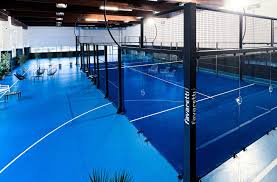

Padel tennis courts are swiftly becoming a focal point for sports enthusiasts worldwide, blending the best attributes of tennis and squash into a thrilling and accessible game. A padel court is typically smaller than a tennis court, enclosed by walls or fencing, which adds a dynamic layer of strategy and skill. Understanding the intricacies of padel tennis courts can drive product development, sales, and investment in this burgeoning sport.

A critical aspect of padel tennis court design is the surface material. Most courts use synthetic turf, providing an optimal balance between grip and comfort. The surface needs to ensure player safety while also allowing for skillful play, including quick direction changes and strategic ball bounces. As a product developer or buyer, attention to the quality and durability of the turf is paramount for promoting longevity and top-notch gameplay.
Another critical feature is the court's enclosure, usually made from glass or metal mesh walls. These not only contribute to the unique gameplay dynamics, allowing the ball to be played off the walls but also require high durability and maintenance standards. The choice between glass and metal should consider local climate conditions and expected usage levels, as these can affect transparency, weather resistance, and cost implications over time.

Lighting is a key component that must be addressed for evening play and to enhance the visual experience for both players and spectators. LED lighting solutions are preferred for padel courts due to their energy efficiency and powerful illumination. Ensuring even distribution of light across the court without glare is essential for maintaining fair play and reducing eye strain.
When considering installing a padel tennis court, acknowledging the importance of location and accessibility is crucial. A strategically placed court can serve community centers, sports clubs, and resorts, increasing footfall and revenue opportunities. Additionally, strategic partnerships with existing sports facilities can create mutually beneficial arrangements, improving community engagement and offering diversified recreational activities.
Investing in padel tennis courts also provides a lucrative opportunity to cater to a rapidly growing market. As the sport gains popularity across continents, there is a rising demand for certified training programs and local tournaments, representing an untapped revenue stream. Engaging with professional athletes and accredited coaches can elevate a padel facility's offering, aligning with E-A-T (Experience, Expertise, Authoritativeness, Trustworthiness) principles to attract dedicated participants.
For stakeholders looking to optimize their products and services around padel tennis courts, prioritizing sustainability and innovation is recommended. Incorporating eco-friendly materials and smart technologies not only adheres to modern consumer expectations but also supports operational efficiencies. Additionally, engaging with padel associations and industry experts can provide insights into emerging trends and best practices, fortifying your brand's position as a trusted authority in the padel community.
In conclusion, the ongoing growth of padel tennis offers substantial opportunities for sports entrepreneurs and facility managers. By focusing on high-quality materials, strategic location and design, strong industry partnerships, and sustainable practices, stakeholders can maximize their investment and secure a competitive advantage, all while contributing positively to the sport's development.
High-Performance Industrial Flooring Solutions China Paddle Tennis Court for Sale
High-Performance Industrial Flooring Solutions Durable & Cost-Effective
Homogeneous Transparent Floor – Durable & Stylish Rubber Floor Solutions
Premium Homogeneous Transparent Floor for Durable & Stylish Spaces Rubber Floor Solutions
Premium Sports Floor Solutions Durable PVC Sports Floor & Rubber Floor for Gyms
Durable Rubber Composite Floor Premium Rubber Floor & Mats Solutions